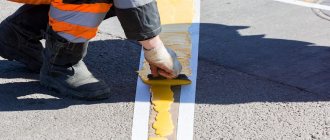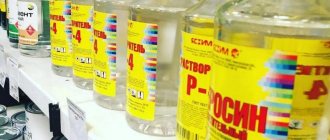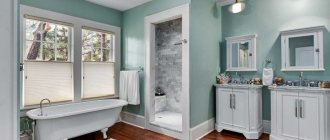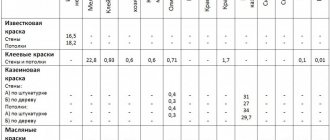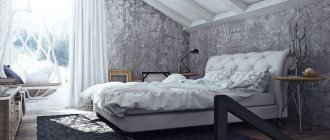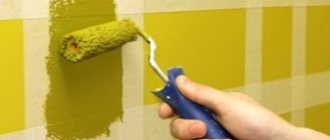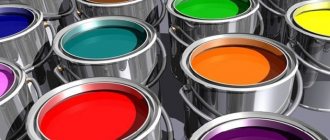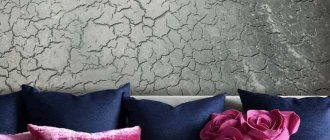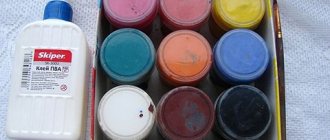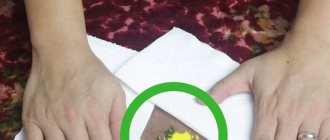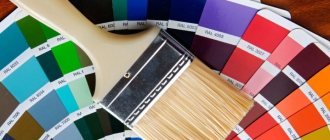There are many paints and varnishes on the modern construction market, but there is a separate type that is in greatest demand. This is acrylic paint, which is often confused with acrylate. And it is the latter that we will talk about in our article today.
The fact is that acrylate paint is really very similar in quality to acrylic paint. The difference lies in the additional components that are added to the mixture.
Description and features of acrylate paint
The basis of such paints is acrylate-copolymer dispersion. The product contains:
- water;
- a solvent that provides the desired viscosity;
- coloring pigment;
- latex, vinyl and styrene;
- a coalescent that binds all paint components;
- a thickener that helps achieve the desired consistency of the composition;
- antioxidant-preservative;
- antifreeze that prevents thickening and premature freezing in the cold.
Thanks to this composition, acrylate paints do not change color for several years and are safe for humans. At the same time, the material can withstand temperature increases only up to +26 degrees. This disadvantage is mitigated by various additives that are added to acrylate. Additional components provide the paint with the following features:
- resistance to open flames;
- dry quickly (within 1-3 hours);
- wide palette of shades;
- elasticity;
- resistance to cleaning agents;
- long service life (up to 10 years).
Among the pronounced features of acrylate paints, they note the ability of the composition, after drying, not to change its original properties in conditions of high humidity, with temperature changes and under direct sunlight.
Expert opinion
Zakharova Irina Yurievna
Cleaning professional with 15 years of experience. Our best expert.
Ask a Question
This material is available in only two forms - basic white and pigmented. Both compositions are mixed before starting work to obtain the desired shade.
Terms of use
Acrylate paints can be used in the absence of precipitation and strong wind (if we are talking about painting a facade), the ambient temperature should be in the range of +20-40°C.
Ignoring these conditions will negatively affect the result, and the service life of the coating will decrease.
Procedure for applying acrylates
How is it different from acrylic?
The basis of both types of paints is polyacrylate. Copolymers are introduced into the composition of acrylate materials, which impart additional properties:
- increased viscosity;
- increased vapor permeability;
- increased density and so on.
See also
Composition and technical characteristics of AK-511 paint, rules of use
Also, depending on the type of additional components, the scope of application of paints and varnishes changes. Otherwise, the difference between acrylic and acrylate compositions is not noticeable.
Types of varnishes: choosing the right ones
The great Stradivari devoted his entire life to one goal - to achieve maximum purity of the sound of the violin. The composition and method of coating played a primary role in this. However, in the time of the master, only oil varnish was used, the secret of which was passed down from generation to generation.
The world has changed. The rapid development of technology gives us a wide selection of materials for coating products, including varnishes. Our review will help you choose the most suitable material for your tasks, so that your handmade item continues to please you for as long as possible.
Content
Operating procedure
The application of acrylate paints is carried out according to a specific algorithm and subject to a number of conditions. The last factor is considered important, since without following the manufacturer’s recommendations, the dried layer will not acquire the properties described above.
Required tools and materials
The volume of paint and varnish materials that need to be purchased depends both on the type of composition and on the area of the work being carried out. On average, surface treatment requires 300-400 milliliters of paint per 1 m2. More precise parameters are indicated on the container with the material.
Additionally, it is recommended to purchase a primer and antiseptic. The latter will be required in cases where wooden structures are painted. The antiseptic will protect the surface from fungus and mold.
Also, to carry out such work you will need a set of brushes and rollers of different sizes. If the ceiling and high walls are being painted, a stepladder is needed. And if you plan to treat large areas, it is recommended to purchase (rent) a paint sprayer.
Surface preparation
Before painting it is necessary;
- clean the surface from old paints;
- remove oily stains using acetone or other similar compounds;
- remove dust and other contaminants;
- level the surface.
See also
How to paint a guitar with your own hands at home and what varnishes to choose
Upon completion of the described actions, you need to prime the surface and apply an antiseptic.
Preparation of the solution
The coloring composition is diluted according to the manufacturer's recommendations. It is impossible to give general advice on how to mix correctly. This is due to the fact that the type of paint is selected taking into account the characteristics of the work being carried out. In some cases, the initial composition must be mixed not only with the pigment, but also with water, which will provide the desired viscosity.
Also, the procedure for preparing acrylate paint depends on the type of material. For wood processing, compounds are used that are not suitable for concrete, and so on.
Coloring
Acrylate paints are applied according to the same scheme as is used when working with other similar materials. It is recommended to work with this composition at temperatures from +5 to +20 degrees and in conditions of average humidity (at high humidity, specialized material is used).
After mixing, the solution must be applied immediately. If you plan to take a break from work, the containers must be closed, since acrylate compounds dry quickly. It is recommended to apply the paint in 3-4 layers, waiting 1-2 hours each time.
Completion
At the end of the work, it is recommended to inspect the painted walls (ceiling, floor, etc.) and, if found, remove any particles of dirt or lint from the brushes (rollers) by applying another layer of material to these places. If necessary, after drying, the surface can be re-treated. Thanks to this, you can make the shade more saturated.
Types of varnishes
Acrylic varnishes (glossy and matte)
Acrylic varnish is the most popular and sought after type of coating among needlewomen. Most often you can find water-based acrylic varnishes on sale, but turpentine-based varnish can be used for oil painting.
The composition is based on colorless, unpainted acrylic resin with the addition of various stabilizers and thickeners.
Acrylic varnish has many advantages. This type of varnish can be considered universal in many respects. First of all, it can be used to cover surfaces made of various materials: wood, plaster, stone, glass, ceramics, cardboard, etc. It is also used not only as a finishing coating, but also mixes well with water-based paints (gouache, tempera, acrylic), giving them greater color saturation. When added to gouache paints, it additionally gives it abrasion resistance.
After drying, the varnish becomes water-insoluble, which allows the surface of the product to be cleaned using aqueous solutions. Acrylic varnish can be applied as a primer on a wide variety of substrate materials. The gypsum surface, after applying primer in the form of acrylic varnish, crumbles significantly less, and it imparts additional rigidity to the textile substrate.
It is common to use acrylic varnish as a binder for making paints yourself; it gives them depth of color and a silky gloss.
Acrylic varnish is indispensable in decoupage. It is actively used as a finishing coating for various decorative products: boxes, watches, panels, mirrors, figurines and photo frames. Acrylic varnish is excellent for revarnishing colored coatings, and also allows you to soften the boundaries of transitions and protect the intermediate layers of the product.
The varnish is already ready for use; there is no need to further dilute it. However, if the varnish has thickened, it can be “revitalized” simply by adding a little water. Also, experienced craftswomen advise that when applying the first layer of varnish, make it as liquid as possible, and subsequent layers are thicker.
The main disadvantage of this type of varnish is that for its normal crystallization, it is necessary to maintain air humidity of at least 50% during the entire drying period, which is very difficult to achieve in winter.
To summarize, acrylic varnish is water-soluble, practically odorless, does not burn, becomes completely transparent after drying, does not turn yellow over time, and can be used on almost all materials. Environmentally friendly material. There are three types - glossy, matte and semi-matte (satin). For application use synthetic brushes or rollers. Manufacturers also offer varnish in the form of an aerosol, the use of which allows you to achieve a more uniform coating, without brush marks.
Alkyd varnish
Alkyd varnish is based on a mixture of alkyd resins with an organic solvent. This type of coating is characterized by high moisture resistance, tolerates sudden temperature changes, and has high decorative qualities. It has no equal in creating a protective layer that prevents mechanical stress. Alkyd varnish, penetrating into the deep layers of wood, emphasizes the natural beauty of the material.
Alkyd varnish is used to cover products that will be used intensively. When applied to wood, it becomes not susceptible to rotting and fungus, and alkyd varnish protects metal products from corrosion. Products coated with alkyd varnish are fire-resistant.
The consumption of alkyd varnish is significantly less when compared with acrylic varnish.
The main disadvantages are that it is toxic, has a fairly long drying period, and also has a pronounced unpleasant odor. It is necessary to work with such varnish in a well-ventilated area, taking all necessary precautions to avoid intoxication.
For application, brushes or special rollers with a porous base are used.
Nitrolac
Nitrovarnish is a synthetic varnish that has a similar composition to alkyd, but dries much faster. The scope of application of nitro varnish is the creation of a protective and decorative coating for wood products. After varnishing, the product can be polished.
The varnish is ready for use and does not require preliminary priming of the surface, as it has high adhesion. Apply by brush, roller or spray gun.
Yacht varnish
Yacht varnish belongs to the construction varieties. As a coating for creative works, yacht varnish has proven itself to be an excellent topcoat for products that are used in harsh weather conditions: weather vanes, feeders, door signs, outdoor decorative elements. Such products are often made using the decoupage technique.
Tsapon
It is a mixture of artificial resins and nitrocellulose. Organic dyes can be added to the varnish.
A distinctive feature of Tsapon varnish is heat resistance. The coating is applied in two layers over acrylic varnish. Used for decorating thermal mugs, hot pads, tabletops, trays.
Conclusion
Acrylate paints are ideal for painting all types of facades. They are weatherproof, wear-resistant, durable, impact-resistant and resistant to mechanical stress. Due to the presence of copolymers, they are not as expensive as acrylic counterparts.
If you have questions, ask them in the comments. Therefore, I say goodbye and success to you in your endeavors.
Before starting repairs, users have many questions. Many people cannot decide which paint to use. The most popular are latex and acrylic compositions. In the construction market, they are often confused, so it can be difficult for an ordinary buyer to make a choice in favor of a specific product.
Properties
The qualities of the water-dispersion material depend on the dispersion copolymer, one of the 5 listed in the “Composition” paragraph:
- polyvinyl acetate;
- butadiene styrene;
- styrene acrylate;
- acrylate;
- versatata.
Let us consider one by one the properties of water-based paints containing one of them as a base:
- yellowing, lack of resistance to water, for this reason a narrow scope of application - only in rooms with a normal level of humidity, on surfaces that do not require wet cleaning, and are not subject to mechanical stress;
- good water resistance, but susceptible to UV radiation, application is slightly wider, but still limited to indoor surfaces;
- porosity of the coating, forming vapor permeability, resistance to fading in light, tight adhesion to many surfaces - high adhesion, as a result of wider application on internal and some external surfaces;
- the highest resistance to light, all the advantages have been improved and allow the active use of this type of acrylic water-dispersion paint in unprotected conditions of the natural environment - on the street, that is, in exterior decoration (facades made of different materials - wood, plaster);
- excellent quality characteristics comparable to all the advantages of the listed acrylic paints.
Latex acrylic paints, created on the basis of synthetic rubber - styrene butadiene, with silicone additives, have a number of advantages:
- water resistance – form a washable surface, suitable for use in rooms with high humidity;
- elasticity - will not crack;
- adhesion;
- vapor permeability, but against fungus it is better to use a preliminary primer;
- wear resistance - for rooms with intense loads;
- variety of decorative effects;
- non-flammability.
Like all water-based paints, it is environmentally friendly, as it does not contain toxic organic solvents, dries quickly, and is odorless.
All water-dispersed materials can be tinted, they are easy to work with, and are resistant to alkalis.
Definition
Water-soluble paint and varnish products are a combination of precisely selected proportions of chemically active components. The components improve each other’s properties, increase important characteristics, and reduce the incidence of undesirable effects.
Main components:
- The polymer is a binding base, improves the adhesion of the solution to the surface being painted, extends its service life, and resists negative factors.
- Pigment is a powder suspension that colors the base. Added by manufacturer, sold separately.
- A filler with a structure similar to pigment enhances paint durability and gives the surface a matte, glossy finish.
- Solvent is the basis of the mixture, added in the required quantity by the manufacturer, it increases or decreases the viscosity of substances.
- Additives help improve performance and create new properties.
The division into groups is made by choosing a similar binder polymer:
- polyvinyl acetate;
- butadiene styrene;
- acrylic silicone;
- acrylic;
- rubber acrylate-latex.
Advantages
There are many characteristics that attract buyers. There are insignificant differences between identical solutions from different manufacturers, so it is recommended that you review the properties of interest in the instructions before purchasing.
Main advantages:
- Easy to apply using any known method, covers the base well.
- No sharp, unpleasant odor. It is allowed to paint children's rooms.
- Good quality coating, long service life.
- Environmentally friendly basis, safety, no chemical impurities that negatively affect health.
- Available in white, pigments are used to add shades.
- Economical - low cost when compared with other varieties.
- Availability – prices are relatively low, good quality.
- Dries quickly, re-painting is carried out after 6 hours.
- Moisture and ultraviolet radiation do not have a negative effect.
Flaws
There are several criteria that repel buyers:
- Increased requirements for the base - ideal evenness, absence of debris, high adhesive qualities. A thin layer does not hide unevenness, defects, or chips of the previous finish.
- Surface cracking occurs under the influence of low temperatures, temperature changes, and drafts.
- Harmless composition - an advantage and a disadvantage. The coloring solution is harmless to humans, microorganisms, bacteria, fungi, and pests. It is recommended to treat the base with antiseptic substances before painting.
How to choose?
To choose a paint, you need to choose the right color and understand all the characteristics it has. Particular attention should be paid to the degree of gloss - there are several of them.
The highest degree is rarely purchased, because it affects the specularity of the reflections of the planes. This effect often adversely affects the perception of the interior as a whole. Thus, matte paint has a reputation as the most common.
No less important parameters are moisture resistance and wear resistance. The first is determined by the number of abrasion cycles, which is usually indicated on the packaging. Wet abrasion cycles mean the paint is moisture resistant, while dry abrasion cycles mean the paint is not moisture resistant.
You should also pay attention to such characteristics as thixotropy and hiding power. The first is responsible for the occurrence of leaks. Thixotropy affects how quickly the paint thickens.
With prolonged thickening, streaks appear. Covering power shows the formation of a film without bald spots - consumption for normal coverage.
Differences
Acrylic and latex mixtures are similar in many ways. However, the acrylic composition differs from mixed latex options in its content.
- in latex paint the binder is styrene butadiene;
- in acrylic - acrylic latex.
They are synthetic resins. It is worth considering one more fact - natural latex derived from the rubber tree is not added to these paints.
Very often, such paint and varnish coatings are not distinguished because they have similar operational and physical characteristics. These finishing materials form a protective elastic film when dry. But acrylic has surpassed latex in terms of the strength characteristics of the final coating, because it is more moisture- and wear-resistant.
Manufacturers
Today, latex-based paints are very popular and in demand. Many well-known manufacturers offer high-quality, durable and reliable options. There are many positive reviews about the products of many companies, such as Tikkurila, Parade, Dulux, Dufa, Din Profilux, Pufas. Among Russian manufacturers, it is worth highlighting “Tex”.
Finnish Tikkurila paints have an excellent reputation. They can be used to paint previously painted, puttied, concrete and plastered surfaces. The company offers a wide selection of them, so you can easily choose the best option depending on the application.
Eco Joker paint is based on acrylic without the addition of organic solvents
The matte washable surface attracts attention with its silky effect. Eco Joker paint is a good choice for painting different surfaces
It looks beautiful on wood, wallpaper and concrete. Ideal for painting brick, cardboard, plaster, and plastered surfaces.
Eco Joker interior paint can be applied to both new and painted surfaces. It is ideal for living rooms, bedrooms and children's rooms. Another advantage is that it dries very quickly, and after just two hours you can apply a new coat of paint.
"Euro 2" is a good solution for painting ceilings, since it is based on a copolymer dispersion. The paint is matte and environmentally friendly. It can even be used for bedrooms and children's rooms. "Euro 3" is perfect for painting wooden surfaces or fiberboard. "Euro 20" is suitable for damp rooms, as well as for painting heating radiators.
The English company Dulux offers products with good coverage. Tinted paints can be used to create stylish interior designs. They are characterized by quick drying and excellent viscosity. For painting wallpaper, Dulux Easy is a good solution, and for painting coatings that require frequent washing, it is worth purchasing Dulux V Sheen.
The German manufacturer Dufa, owned by the Meffert AG Farbwerke concern, is one of the largest manufacturers in Europe. It offers products for interior and exterior use, regardless of surface type.
The products of the German company Pufas are well-known on the Russian market. The brand offers a wide selection of colors, ease of use, versatility and an affordable price.
Matt-Latex latex paint is safe for health because it contains no solvents. It is characterized by elasticity, economy, excellent moisture resistance, durability, gives a glossy shine to the surface and completely dries within a day.
The products of the Swedish company Parade have been in demand in many countries around the world for many years. The brand offers high-quality products at an affordable price, offering a wide range of both interior decoration and facade work.
Parade Diy paint is waterproof, making it an ideal option for decorating bathrooms and kitchens. It fits perfectly on the surface and is characterized by low consumption. The affordable price will appeal to every buyer.
Russian paint and varnish products have a good price-quality ratio. It offers facade and interior options, a wide selection of colors, excellent quality, strength and elasticity. Many consumers leave extremely positive reviews about the brand's products.
Russian offers high-quality acrylic-based paints. The advantage of the product is that it does not drip or run off. The painted surface allows air to pass through well and is not prone to the formation of fungus and mold. If we talk about the disadvantages, then before using the product you must first apply a primer to the surface planned for painting.
